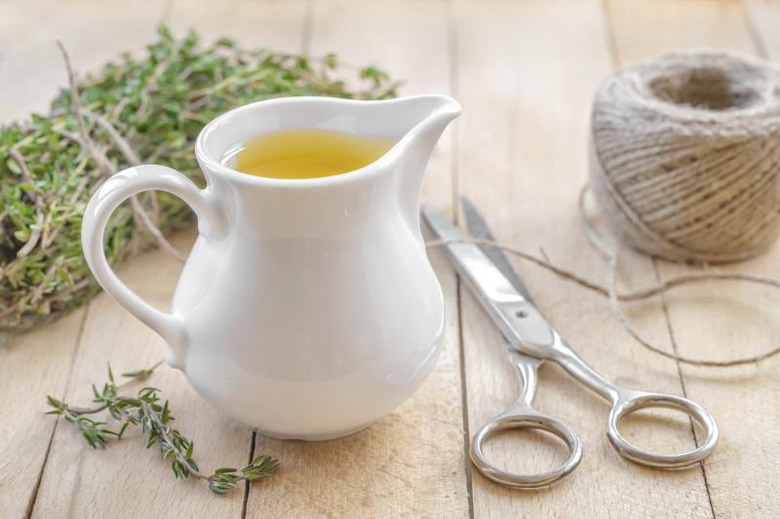How Long Is It Before Creeping Thyme Spreads?
The herb thyme (Thymus spp.) comes in many different forms, including low-growing groundcovers known as creeping thymes. This aromatic group encompasses several different species, all of which spread at different rates. Whether you want to fill a tiny, tight space on a flagstone path or carpet a large area beneath a shrub, selecting the right creeping thyme for the job helps ensure you'll get the results you desire.
Growth Habit
Step 1
Creeping thyme heights vary from 1 to 4 inches with spreads up to 24 inches or more. Foliage colors range from silvery gray to dark green. Some flower very little; others burst into profusions of red, rose, lavender or white. All creeping thymes spread by sending stems along the ground's surface to periodically grow leaves and roots. Those with long segments between leaves cover ground quickly but end up being much less dense. Types with short stems spend less energy spreading and more making leaves and roots. These types grow more slowly but result in dense carpets that can even withstand some foot traffic. The less space between leaves, the slower your thyme will spread. Longer segments mean faster growth. Generally, creeping thyme takes one year to get established, and then begins to spread in its second season.
- The herb thyme (Thymus spp.)
- All creeping thymes spread by sending stems along the ground's surface to periodically grow leaves and roots.
Culture
Step 1
Native to Mediterranean regions, creeping thymes prefer dry, well-drained locations with average soil and five or more hours of daily sun. Although they tolerate drought, rocky soils, air pollution and even deer, they don't handle humidity or overwatering well. Too much water or heavy, poorly draining soils lead to root rot, and failure to thrive and spread at normal rates. Dryness actually improves this plant's vigor, and nonfertile soils increase aromatic oils. Regardless of variety, the shallow roots stay near the surface. To restrain them, pull them out, but select the proper type upfront instead so you can spend time enjoying its beauty instead of preventing it from spreading where you never intended it to go.
Fast Spreaders
Step 1
Fast-spreading creepers will fill large areas by the end of their second season. "Pink Ripple" (Thymus serpyllum "Pink Ripple") quickly spreads to 18 inches with its fresh, lemony fragrance. It is hardy in U.S. Department of Agriculture plant hardiness zones 4 through 9. Creeping pink thyme (Thymus praecox arcticus), hardy in USDA zones 5 though 9, covers 18 to 24 inches by the end of its second year. It has 1- to 2-inch stem segments and deep, reddish-purple flowers. Caraway thyme (Thymus herba-barona), the only creeping thyme with culinary value, sends out caraway-scented foliage on vigorous red stems that will spread to 24 inches or more in two seasons. Use it only where space is not a concern. Hardy in USDA zones 5 through 11, it reaches 4 inches tall with rosy pink flowers.
- Native to Mediterranean regions, creeping thymes prefer dry, well-drained locations with average soil and five or more hours of daily sun.
- Caraway thyme (Thymus herba-barona), the only creeping thyme with culinary value, sends out caraway-scented foliage on vigorous red stems that will spread to 24 inches or more in two seasons.
Slow Spreaders
Step 1
Tight spots call for slow-spreading thymes that complement rather than conceal. Woolly thyme's (Thymus pseudolanuginosus) fuzzy foliage slowly forms a handsome, dense, silvery mat just 1 inch tall. It eventually reaches 12 inches across by the end of its second season. Hardy in USDA zones 5 through 8, it tolerates light shade but rarely blooms. "Pink Chintz" (Thymus serpyllum "Pink Chintz"), hardy in USDA zones 4 through 9, spreads to 12 to 18 inches in two seasons with small, gray leaves and pink blooms. "Elfin" (Thymus praecox arcticus "Elfin"), hardy in USDA zones 4 though 8, is among the slowest-growing thymes of all. Its diminutive leaves form a dense cushion 1 to 2 inches tall, perfect for your tiniest spaces, as it spreads barely 6 inches its first two years.
- Tight spots call for slow-spreading thymes that complement rather than conceal.
- Pink Chintz" (Thymus serpyllum "Pink Chintz"), hardy in USDA zones 4 through 9, spreads to 12 to 18 inches in two seasons with small, gray leaves and pink blooms. "
References
- Fine Gardening: Thyme, the Fragrant Ground Cover
- Mountain Valley Growers: Ground Cover Thymes
- Missouri Botanical Garden Plant Finder: Thymus
- Fine Gardening Plant Guide: Genus Thymus (Thyme)
- V.J. Billings; Herb Authority and Grower; Mountain Valley Growers; Squaw Valley, California
